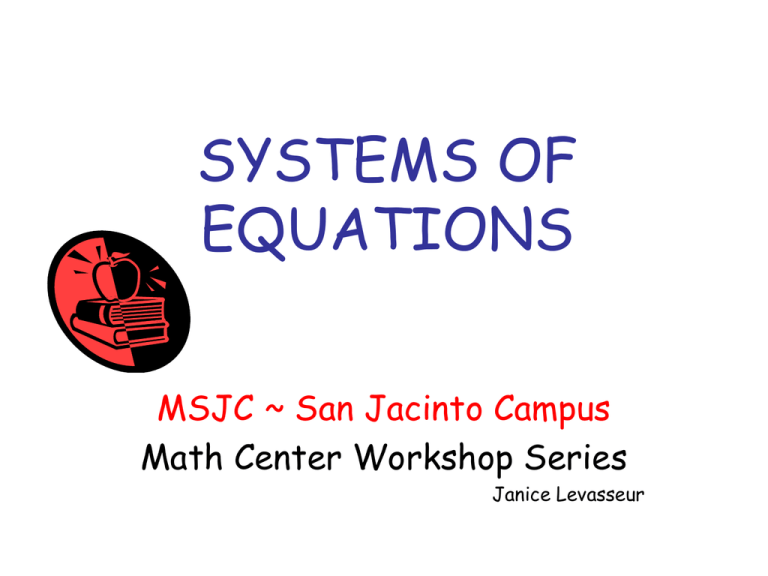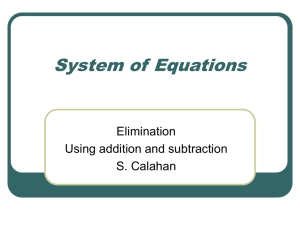13 system of equations
advertisement

SYSTEMS OF EQUATIONS MSJC ~ San Jacinto Campus Math Center Workshop Series Janice Levasseur System of Equations • A system of equations is two or more equations to be solved simultaneously • A solution of a system of equations is a solution that makes each equation true • We will work with a system of two equations with two unknowns (variables) Ex: Determine if the point (1,5) is a solution to the system 5x – 2y = -5 3x – 7y = - 32 • Is the point a solution to the first equation? • Check by plugging in x = 1 and y = 5 5(1) – 2(5) = 5 – 10 = - 5 YES • Is the point a solution to the second equation? • Check by plugging in x = 1 and y = 5 3(1) – 7(5) = 3 – 35 = - 32 YES • Therefore, (1,5) is a solution to the system. Ex: Determine if the point (4,2) is a solution to the system 3y – 2x = - 2 y + 2x = 8 • Is the point a solution to the first equation? • Check by plugging in x = 4 and y = 2 (careful!) 3(2) – 2(4) = 6 – 8 = - 2 YES • Is the point a solution to the second equation? • Check by plugging in x = 4 and y = 2 (careful!) 2 + 2(4) = 2 + 8 = 10 NO • Therefore, (4,2) is not a solution to the system. Recall linear equations y = mx + b • The graph of the line is the solution set. (i.e. every point on the line is a solution to the equation y = mx + b) Ex: Graph y = 2x – 1 Plugging in values for x we find three solutions • (0, -1) • (-1, -3) • (1, 1) (Remember, there are an infinite number of possible solutions) Plotting the points we get Graph y = 2x – 1 (0, -1) (-1, -3) (1, 1) Recall: every point on the line is a solution to the equation y = 2x - 1 Plotting two lines on the same set of axes • If we were to plot two lines on the same set of axes, the lines will intersect either one time no times (i.e. never intersect) an infinite number of times • The point(s) of intersection is/are the solution(s) to the system of equations Ex: Plot on the same set of axes y = (3/2)x + 1 & y = (-1/4)x – (5/2) • Picking “nice” values of x we find the following three solutions for the 1st and 2nd equations: y = (3/2)x + 1 • (-2, -2), (0, 1), and (2, 4) y = (-1/4)x – (5/2) • (-4, -3/2), (0, -5/2), and (4, -7/2) • Plot each line on the same set of axes Graph y = (3/2)x + 1 Graph y = -(1/4)x – (5/2) (-2, -2) (-4, -3/2) (0, 1) (0, -5/2) (2, 4) (4, -7/2) the lines intersect one time at (-2, -2) the solution to the system of equations is (-2, -2) The system of equations is Independent Ex: Plot on the same set of axes y = x + 2 and y = x – 1 • Picking values of x we find the following three solutions for the 1st and 2nd equations: y=x+2 • (-1, 1), (0, 2), and (1, 3) y=x–1 • (-1, -2), (0, -1), and (1, 0) • Plot each line on the same set of axes Graph y = x + 2 Graph y = x – 1 (-1, 1) (-1, -2) (0, 2) (0, -1) (1, 3) (1, 0) the lines are parallel, therefore they never intersect there is no solution to the system of equations The system of equations is Inconsistant Ex: Plot on the same set of axes y = (1/3)x + 2 and –x + 3y = 6 • Picking “nice” values of x we find the following three solutions for the 1st and 2nd equations: y = (1/3)x + 2 • (-3, 1), (0, 2), and (3, 3) –x + 3y = 6 • (-3, 1), (0, 2), and (3, 3) Graph y = (1/3)x + 2 Graph –x + 3y = 6 (-3, 1) (-3, 1) (0, 2) (0, 2) (3, 3) (3, 3) the lines are identical therefore intersect at every point on the lines there is an infinite number of solution to the system of equations The system of equations is Dependent Types of Systems • A system of equations with one solution (the lines intersect one time) is said to be independent • A system of equations with no solutions (the lines are parallel) is said to be inconsistent • A system of equations with an infinite number of solutions (the lines are the same) is said to be dependent Ex: Graph the system to solve: x–y=2 x+y=6 • Using the slope-intercept form of the equations we find • Equation 1: x – y = 2 y = x – 2 m = 1 and b = - 2 • Equation 2: x + y = 6 y = - x + 6 m = - 1 and b = 6 • Graph Eq 1: y = x – 2 m = 1 and b = - 2 • Graph Eq 2: y = - x + 6 m = - 1 and b = 6 Start on the y-axis at 6 Using m = -1 down 1, right 1 Start on the y-axis at -2 Using m = 1 up 1, right 1 The lines intersect one time at the point (4, 2) (4, 2) is the solution to the system Your turn to try a few An Algebraic Solution to a System of Equations • The graphical method to solve a system of equations helps us understand what the solution of a system is. • However, unless that intersection occurs at a “nice point” it will be difficult to pinpoint the solution. • We need an algebraic approach to solving a system of equations. The Substitution Method The Substitution Method is an algebraic approach to solving a system of equations. 1. In one of the equations, solve for one of the variables. 2. Plug the expression for that variable into the other equation and simplify. You now have an equation in a single variable. 3. Solve the single-variable equation for the remaining variable. 4. Evaluate the expression found in Step 1 using the value of the variable found in Step 3 to solve for the other variable. 5. Write the solution as an ordered pair, alphabetically, and check Ex: Solve the system y = x – 6 Equation 1 x + y = - 2 Equation 2 Step 1: Solve one equation for one variable. DONE, Equation 1: y=x–6 Step 2: Plug the expression for that variable into the other equation and simplify. x + (x – 6) = - 2 2x – 6 = - 2 (adding 6 to both sides) 2x = 4 (dividing both sides by 2) x =2 Equation 2: x + y = - 2 Ex: Solve the system y=x–6 x+y=-2 x =2 Step 4: Evaluate the expression found in Step 1 using the value of the variable found in Step 3 to solve for the other variable. Equation 1: y = x - 6 y = 2 - 6 y=–4 Step 5: Write the solution as an ordered pair & check. Solution: (2, - 4) Check: Equation 1: y = x – 6 - 4 = 2 – 6? YES! Equation 2: x + y = - 2 2 + (-4) = - 2? YES! Ex: Solve the system x – y = - 3 Equation 1 2x + 3y = - 6 Equation 2 Step 1: Solve one equation for one variable. Equation 1 solve for x: x = y – 3 Step 2: Plug the expression for that variable into the other equation and simplify. Equation 2: 2x + 3y= - 6 2(y – 3) + 3y = - 6 2y – 6 + 3y = - 6 5y – 6 = - 6 Step 3: Solve the equation for the remaining variable. 5y – 6 = - 6 5y = 0 (adding 6 to both sides) y = 0 (dividing both sides by 5) Step 4: Evaluate the expression found in Step 1 using the value of the variable found in Step 3 to solve for the other variable. Step 1: x = y – 3 x=0-3 x=-3 Step 5: Write the solution as an ordered pair & check. Solution: (- 3, 0) Check: Equation 1: x – y = - 3 - 3 – 0 = - 3? YES! Equation 2: 2x + 3y = - 6 2(-3)+3(0) = - 6? YES! Ex: Solve the system y – 2x = – 6 Equation 1 2y - x = 5 Equation 2 Step 1: Solve one equation for one variable. Equation 1 solve for y by adding 2x to both sides: y = 2x – 6 Step 2: Plug the expression for that variable into the other equation and simplify. Equation 2: 2y – x = 5 2(2x – 6) – x = 5 4x – 12 – x = 5 3x – 12 = 5 Step 3: Solve the equation for the remaining variable. 3x – 12 = 5 3x = 17 (adding 12 to both sides) x = 17/3 (dividing both sides by 3) Step 4: Evaluate the expression found in Step 1 using the value of the variable found in Step 3 to solve for the other variable. y = 2(17/3) - 6 y = 16/3 Step 1: y = 2x - 6 Step 5: Write the solution as an ordered pair & check. Solution: (17/3, 16/3) Check: Equation 1: y – 2x = – 6 16/3 – 2(17/3) = – 6? YES! Equation 2: 2y – x = 5 2(16/3) – (17/3) = 5? YES! Your turn to try a few The Elimination Method The Elimination Method is another algebraic approach to solving a system of equations. 1. Use the Multiplication Principle for Equations to set up the system so that the coefficients of one of the variables are opposites. 2. Add the equations to “eliminate” one of the variables. 3. Solve the single-variable equation for the remaining variable. 4. “Backsolve” – solve one of the original equations for the other variable, using the value of the first variable found in Step 3. 5. Write the solution as an ordered pair, alphabetically, and check Ex: Solve the system x + y = 8 Equation 1 - x + 2y = 7 Equation 2 Step 1: set up the system so that the coefficients of one of the variables are opposites. Done. The coefficients of x are 1 and - 1 Step 2: Add the equations to “eliminate” one of the variables. Step 3: Solve the equation Equation 1 x+y =8 for the remaining variable. -x + 2y = 7 Equation 2 (dividing both sides by 3) y =5 3y = 15 Step 4: “Backsolve” – solve one of the original equations for the other variable, using the value of the first variable found in Step 3. Equation 1: x + y = 8 x + 5 = 8 x=3 Step 5: Write the solution as an ordered pair & check. Solution: (3, 5) Check: Equation 1: x + y = 8 3 + 5 = 8? YES! Equation 2: - x + 2y = 7 - 3 + 2(5) = 7? YES! Ex: Solve the system 3x – y = 8 Equation 1 x + 2y = 5 Equation 2 Step 1: set up the system so that the coefficients of one of the variables are opposites. The coefficients of y are opposite in sign: -1 and 2. If the -1 was a -2, then the coefficients of y would be opposites. Multiply Equation 1 through by 2 to obtain an equivalent equation: 2[3x – y = 8] 6x – 2y = 16. Step 2: Add the equations to “eliminate” one of the variables. 6x – 2y = 16 x + 2y = 5 7x = 21 Equation 1 multiplied by 2 Equation 2 x =3 Step 3: Solve the equation for the remaining variable. Step 4: “Backsolve” Equation 1: 3x – y = 8 3(3) – y = 8 9–y=8 y=1 Step 5: Write the solution as an ordered pair & check. Solution: (3, 1) Check: Equation 1: 3x – y = 8 3(3) - 1 = 8? YES! Equation 2: x + 2y = 5 3 + 2(1) = 5? YES! Ex: Solve the system 2w – 3z = - 1 Equation 1 3w + 4z = 24 Equation 2 Step 1: set up the system so that the coefficients of one of the variables are opposites. The coefficients of z are opposite in sign: -3 and 4. Question: What is the LCM(-3, 4)? 12 Multiply Equation 1 through by 4 to obtain an equivalent equation: 4[2w – 3z = -1] 8w – 12z = - 4. Multiply Equation 2 through by 3 to obtain an equivalent equation: 3[3w + 4z = 24] 9w + 12z = 72. The coefficients of z are now opposites: - 12 and 12. Step 2: Add the equations to “eliminate” one of the variables. 8w – 12z = - 4 9w + 12z = 72 17w = 68 Equation 1 equivalent Equation 2 equivalent Step 3: Solve the equation for the remaining variable. 17w = 68 w = 4 (dividing both sides by 17) Step 4: “Backsolve” Equation 1: 2w – 3z = -1 2(4) – 3z = -1 8 – 3z = - 1 - 3z = - 9 z=3 Step 5: Write the solution as an ordered pair (in alphabetical order) & check. Solution: (w, z) (4, 3) Check: Equation 1: 2w – 3z = - 1 2(4) – 3(3)= -1? YES! Equation 2: 3w + 4z = 24 3(4) + 4(3)= 24? YES! Your turn to try a few








